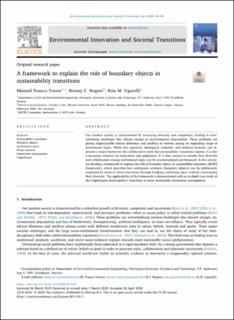| dc.contributor.author | Franco Torres, Manuel | |
| dc.contributor.author | Rogers, Briony | |
| dc.contributor.author | Ugarelli, Rita Maria | |
| dc.date.accessioned | 2020-10-01T14:40:44Z | |
| dc.date.available | 2020-10-01T14:40:44Z | |
| dc.date.created | 2020-06-02T12:19:12Z | |
| dc.date.issued | 2020 | |
| dc.identifier.citation | Environmental Innovation and Societal Transitions. 2020, 36 34-48. | en_US |
| dc.identifier.issn | 2210-4224 | |
| dc.identifier.uri | https://hdl.handle.net/11250/2680764 | |
| dc.description.abstract | Our modern society is characterized by increasing diversity and complexity, leading to overwhelming challenges like climate change or environmental degradation. These problems are posing impracticable ethical dilemmas and conflicts of interest among an expanding range of institutional logics. While this cognitive, ideological, scientific, and political diversity can represent a major barrier for the collaborative work that sustainability transitions require, it is also a necessary resource for innovation and adaptation. It is then natural to wonder how diversity and collaboration among institutional logics can be accommodated and balanced. In this article, we develop a framework to explain the role of boundary objects in sustainability transitions (BOIST framework), which describes how ambiguous artefacts (boundary objects) can be deliberately employed by actors to drive transitions through bridging conflicting logics without constraining their diversity. The applicability of the framework is demonstrated with an in-depth case study of the Copenhagen municipality’s transition to more sustainable stormwater management. | en_US |
| dc.language.iso | eng | en_US |
| dc.publisher | Elsevier | |
| dc.rights | CC BY 4.0 | * |
| dc.rights.uri | https://creativecommons.org/licenses/BY/4.0/ | * |
| dc.subject | Sustainability transitions | en_US |
| dc.subject | Boundary objects | en_US |
| dc.subject | Institutional logics | en_US |
| dc.subject | Water sensitive | en_US |
| dc.subject | Stormwater management | en_US |
| dc.subject | Copenhagen | en_US |
| dc.title | A framework to explain the role of boundary objects in sustainability transitions | en_US |
| dc.type | Peer reviewed | en_US |
| dc.type | Journal article | en_US |
| dc.description.version | publishedVersion | en_US |
| dc.rights.holder | © 2020 The authors | |
| dc.subject.nsi | VDP::Teknologi: 500 | en_US |
| dc.source.pagenumber | 34-48 | en_US |
| dc.source.volume | 36 | en_US |
| dc.source.journal | Environmental Innovation and Societal Transitions | en_US |
| dc.identifier.doi | 10.1016/j.eist.2020.04.010 | |
| dc.identifier.cristin | 1813475 | |
| dc.relation.project | Norges forskningsråd: 237859 | en_US |
| dc.relation.project | Norges forskningsråd: 257267 | en_US |
| cristin.ispublished | true | |
| cristin.fulltext | original | |
| cristin.fulltext | original | |
| cristin.qualitycode | 1 | |

